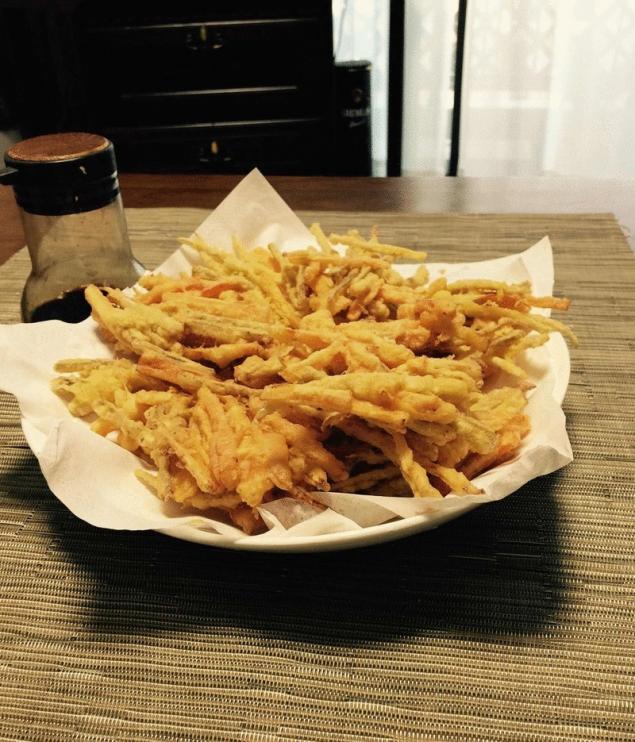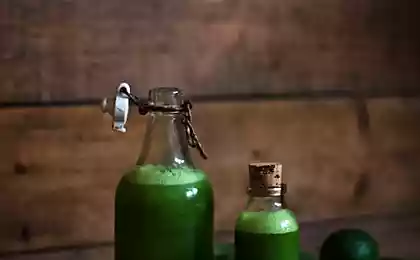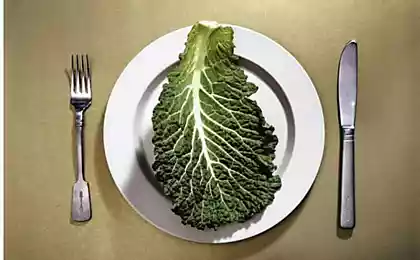460
Burdock root — the food of centenarians
In Japan burdock is known from Jomon, that is around 16,500 years ago. Its production and popularity as a valuable food product belongs to the Edo period. That is, not so long ago it began to be made specifically with the purpose of culinary consumption, only some 400 years ago. Produced with the same scale as the Lotus. Field garden thistles are not inferior in beauty to his yupster the fellow Lotus.

Of course, the Japanese and then follow the Golden rule: who tops, and roots.

However, unlike "inches" Lotus, agrimony tops is more practical. Greens is also allowed in the course, particularly humanitie eat and actually own mugs.

However, seasonality has not been canceled. Agrimony is a spring product. When the leaves are fresh, juicy.
The main part of the ingestion of burdock is the root.

The roots are long and thin, sometimes reaching a meter in length.They are sold unshelled, as contained in the roots of burdock the chlorogenic acid in the purification of the fetus from the skin decreases dramatically. It also becomes less if the peeled roots are soaked. Therefore, in the supermarket, when other vegetables are clean, shiny, Packed in beautiful bags, — burdock root is sold in the pouches, adhered to him to the ground. Right here in the same form as in the picture above.
Of of burdock root make a hot snack "kinpira-gobo". "Gobo" is the actual name of burdock root in Japanese (牛蒡).
A "chimpira"(金平) is the name of the dishes. Allegedly, the dish so called, the name of the son of a samurai Sakata Kintoki. His son was the name — Kimera. And according to legend it is the name of the boy called the dish of mugs.

Anyway, it's clear already, right? That the Japanese are not one to eat raw fish. A lot eat of vegetables, herbs, root crops. Nutritional value of burdock, aka garden thistles, will surpass several times his friend, Lotus.
Burdock root is very rich in polyphenol, a huge list of vitamins, have many useful properties. For the female body one of the key foods. Older people generally "prescribed", as it solves the problem with the intestines. The fact that the Japanese live long and look good, they are required primarily for its healthy cuisine, which is one of the places rightfully allocated to the mugs.
Friends, especially now I dropped everything to go to the store to buy the burdock root and cook him dinner. Here's a pack of burdock roots. In Japanese sounds just "gobo", accent on the second o

In the bag are only two of the spine and there is this thing only 100 yen, that is approximately 1 dollar.
Something that is too clean gobo sold.
I take one root. One is enough.
Will do today it from the tempura. For tempura I have the special flour is the highest quality, as dust. Breed it with the egg and water. Salt pour. All made by eye. Consistency as on pancakes. Maybe a little thinner. Cut burdock root (1pc), carrots (1pc) strips.
And all this collapsing business all cooked dough, fried in boiling oil
Use a ladle (old), which dumplings are caught.So convenient to do "a handful", I mean "chunks" of fried and placed in a "pile" on the kitchen paper to absorb the excess oil flowing from the tempura.

Take a regular dish on three layers of blotting paper and arrange them on the mound of stacks tempura.
There's no salt, because most consumption need to pour handful of soy sauce, but that is not possible!
From a common dish we eat.
My portion for dinner for two handful of tempura. one serving of. published by P. S. And remember, only by changing their consumption — together we change the world! ©
Join us in Facebook , Vkontakte, Odnoklassniki
Source: japan-walks.livejournal.com/241347.html

Of course, the Japanese and then follow the Golden rule: who tops, and roots.

However, unlike "inches" Lotus, agrimony tops is more practical. Greens is also allowed in the course, particularly humanitie eat and actually own mugs.

However, seasonality has not been canceled. Agrimony is a spring product. When the leaves are fresh, juicy.
The main part of the ingestion of burdock is the root.

The roots are long and thin, sometimes reaching a meter in length.They are sold unshelled, as contained in the roots of burdock the chlorogenic acid in the purification of the fetus from the skin decreases dramatically. It also becomes less if the peeled roots are soaked. Therefore, in the supermarket, when other vegetables are clean, shiny, Packed in beautiful bags, — burdock root is sold in the pouches, adhered to him to the ground. Right here in the same form as in the picture above.
Of of burdock root make a hot snack "kinpira-gobo". "Gobo" is the actual name of burdock root in Japanese (牛蒡).
A "chimpira"(金平) is the name of the dishes. Allegedly, the dish so called, the name of the son of a samurai Sakata Kintoki. His son was the name — Kimera. And according to legend it is the name of the boy called the dish of mugs.

Anyway, it's clear already, right? That the Japanese are not one to eat raw fish. A lot eat of vegetables, herbs, root crops. Nutritional value of burdock, aka garden thistles, will surpass several times his friend, Lotus.
Burdock root is very rich in polyphenol, a huge list of vitamins, have many useful properties. For the female body one of the key foods. Older people generally "prescribed", as it solves the problem with the intestines. The fact that the Japanese live long and look good, they are required primarily for its healthy cuisine, which is one of the places rightfully allocated to the mugs.
Friends, especially now I dropped everything to go to the store to buy the burdock root and cook him dinner. Here's a pack of burdock roots. In Japanese sounds just "gobo", accent on the second o

In the bag are only two of the spine and there is this thing only 100 yen, that is approximately 1 dollar.
Something that is too clean gobo sold.
I take one root. One is enough.
Will do today it from the tempura. For tempura I have the special flour is the highest quality, as dust. Breed it with the egg and water. Salt pour. All made by eye. Consistency as on pancakes. Maybe a little thinner. Cut burdock root (1pc), carrots (1pc) strips.
And all this collapsing business all cooked dough, fried in boiling oil
Use a ladle (old), which dumplings are caught.So convenient to do "a handful", I mean "chunks" of fried and placed in a "pile" on the kitchen paper to absorb the excess oil flowing from the tempura.

Take a regular dish on three layers of blotting paper and arrange them on the mound of stacks tempura.
There's no salt, because most consumption need to pour handful of soy sauce, but that is not possible!
From a common dish we eat.
My portion for dinner for two handful of tempura. one serving of. published by P. S. And remember, only by changing their consumption — together we change the world! ©
Join us in Facebook , Vkontakte, Odnoklassniki
Source: japan-walks.livejournal.com/241347.html
5 interesting recipes of stuffed vegetables without meat
5 reasons to STOP saying GOOD to their children























